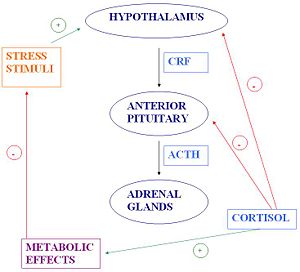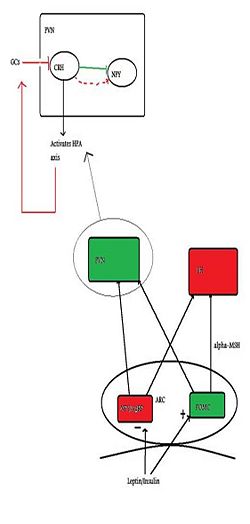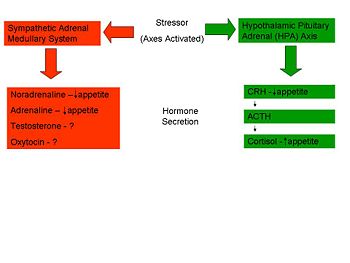Stress and appetite: Difference between revisions
imported>Gareth Leng |
imported>Gareth Leng |
||
| Line 99: | Line 99: | ||
Revision as of 10:27, 25 November 2010
For the course duration, the article is closed to outside editing. Of course you can always leave comments on the discussion page. The anticipated date of course completion is 01 February 2011. One month after that date at the latest, this notice shall be removed. Besides, many other Citizendium articles welcome your collaboration! |
Stress is an emotional and physiological response phenomenon which almost all of us have experienced at some point or another. Although stress is now commonly perceived as social and workplace pressures of modern living leading to increased incidence of illness, stress can be defined as anything that is potentially damaging to the internal homeostasis of an organism. Stressors may be either emotional and physical. Emotional stressors can be anything from a novel environment to potential embarrassment and involve the perception of the stimuli as being 'stressful' and are processed by the limbic forebrain. On the other hand, physical stressors, e.g. an immune attack or sudden change in temperature, pose an immediate threat and are processed quickly by the brainstem. The stereotypic stress response involves activation of the hypothalamic-pituitary-adrenal (HPA) axis, resulting in heightened vigilance, enhanced cognition and arousal of the autonomic system. [1] These responses help to protect both the body and the brain from any harmful effects of the stress stimuli, although chronic stress states can have detrimental effects on the brain. [2]
The activation of the HPA axis triggers a cascade which ultimately leads to the secretion of the glucocorticoid hormone cortisol from the adrenal cortex. Cortisol acts on the cytoplasmic receptors of many cells to initiate gene transcription and eventually protein synthesis. Cortisol can also have direct membrane effects on some cells, by triggering an increase in calcium influx via voltage-gated ion channels, although the exact mechanism of this remains unknown. While a moderate increase in intracellular calcium increases a cell's excitability, calcium overloading can lead to excitotoxicity and neuron death.
The HPA axis
The HPA axis is comprised of the hypothalamus, the pituitary and the adrenal gland. The hypothalamus is the control centre for most of the hormonal systems in the body, as shown in the figure below. In response to a stressor, be it psychological or physiological, corticotropin-releasing factor (CRF) is secreted. CRF is a polypeptide hormone which is synthesised in the paraventricular nucleus (PVN) of the hypothalamus and released from the median eminance into capillaries that carry it to the pituitary gland (the hypopthalamo-hypophysial portal vessels). There, CRF induces corticotroph cells to secrete adrenocorticotrophic hormone (ACTH). In turn, ACTH acts on the adrenal glands to stimulate the release of adrenal glucocorticoid hormones, of which cortisol is the main one in humans. Cortisol is the 'stress hormone'. Its release triggers negative feedback to the hypothalamus and anterior pituitary, resulting in a fall in circulating ACTH. Cortisol also has metabolic effects, which facilitate a return to homeostasis.
Neural mechanisms of appetite control and the interconnections to the HPA axis
Several peptides circulating in the blood inform the brain about the body’s nutritional status. Insulin and leptin, (which both act to suppress appetite) and ghrelin (which induces appetite) are all thought to be able to cross the blood-brain barrier at the arcuate nucleus, which is one important site of action. In the arcuate nucleus, there are populations of neurons which produce and release substances which have either orexigenic effects (induce feeding) or anorexigeninc effects (suppress feeding). The orexigenic neurons, which signal hunger, or a negative energy state, co-express two orexigenic peptides: neuropeptide Y (NPY), and Agouti-related Peptide (AgRP). These neurones are inhibited by increased levels of insulin and leptin. Conversely, insulin and leptin have excitatory effects on anorexigenic neurons that express pro-opiomelanocortin (POMC) triggering the release of melanocortins (products of POMC). One of the key melanocortins is alpha-MSH, which acts at MC4 receptors to suppress feeding/hunger. AgRP is an inverse agonist at the MC4 receptor, thus increasing NPY/AgRP neurons orexigenic effect [3]
Appetite-regulating neurons of the arcuate nucleus project to other parts of the hypothalamus, including to the lateral hypothalamus (LH), and the paraventricular nucleus (PVN) where second-order signalling is postulated to take place. PVN stimulation causes inhibition of eating, whilst LH stimulation has the opposite effect. It is in the PVN we see the interconnection between feeding control and the HPA (stress) axis and it is here where the main activator of the HPA axis - CRF - is synthesised. NPY neurons have abundant projections to the PVN, and due to their close proximity to CRF cell bodies, NPY has a stimulatory effect on CRF release.[4]
Studies by Jhanwar-Uniyal et al. (1993) demonstrated two important findings; first that PVN is indeed innervated by NPY neurons projecting from the arcuate nucleus (shown by correlation of NPY levels in the PVN and arcuate nucleus, this correlation did not exist for other hypothalamic areas) and secondly, they found that direct injection of NPY into the PVN potently affected eating behaviour, leading to an increase of ingestion of carbohydrate dense food (no increase was seen in ingestion of protein and fat). This preference for carbohydrate dense food when stressed, and its biological relevance, will be discussed later.
The key area of connection between the HPA axis and regulation of feeding is the PVN. Here, there are innervating NPY neurons (Orexigenic) and CRF synthesis. CRF inhibits NPY neurones, thus initially it is anorexigenic, however, glucocorticoids (GCs) feedback to the brain to inhibit CRF expression. With sustained activation of the HPA axis, the less CRF inhibition of NPY neurones, resulting in a greater orexigenic drive.[5]
Acute Stress and Appetite
Why do you reach for that extra double chocolate chip cookie after a stressful day?
Stress affects every body system and contributes to many of the negative health behaviours which impact todays’ society, including cardiovascular disease, diabetes mellitus type 2 and hypertension. With obesity becoming the world-wide epidemic which underlies many of these life-threatening diseases, many researchers have chosen to study the connection between novel stressors and an individual's eating behaviour, including both the amount of food eaten and their choice of food.[6]
Stress can be put into two broad categories: acute stress (short term) and chronic stress (stressors occur regulary, see next section). We respond to acute stress, sometimes by overeating, and sometimes by under-eating, and this may be linked to the particular type of stressor.[7]
'Rodent Studies"
Rodent studies have allowed a greater understanding of the effect of stress on appetite. Experiments can be tightly controlled in a lab environment with close monitoring of stressor type, hormone secretion and the animals weight. This can give valuable insight into the processes which drive humans to eat, as there are very few human studies in the literature, and those that are have limitations on methods for control and self-reporting of dietary intake.
HPA Axis – ‘Uncontrollable Stress’
Rodent studies have illustrated a greater caloric intake during the recovery period from a novel stressor. An ‘uncontrollable stressor’ can lead to the activation of the HPA axis resulting in the immediate release of the appetite depressant CRH. This stimulates the release of cortisol (corticosterone in rodents). Sapolsky perceives the increase in feeding in these individuals to be due to the appetite-stimulating effects of the residual cortisol in the bloodstream following an acute stressor. [7] However, it is not known how cortisol triggers over-eating; studies have shown that there is no direct effect of cortisol but it may influence other factors such as leptin, NPY or certain cytokines which have a more direct effect on eating. [8]
Sympathetic-Pituitary-Adrenal Axis – ‘Controllable Stress’
However, several studies have shown a suppression of eating in response to acute stress. In certain stressful situations, sometimes termed ‘controllable’ stressors, the ‘Fight or Flight’ response is activated rather than the HPA axis. This mechanism, caused by the release of catecholamines (adrenaline and noradrenaline) from the adrenal glands, causes a range of physiological and behavioural changes to allow the individual to cope with the situation. One such change is a reduction in food intake through a slowed gastric emptying and shunting of the blood vessels to the gastrointestinal tract to allow the muscles an increased blood supply. [7]
Chronic Stress
Chronic stress is the brain’s response to unpleasant events over a long period of time (greater than 24 hours). Examples of chronic stress include job pressures or mental health diseases. While acute stress results in the inhibition of CRF and ACTH secretion by increased glucocorticoid levels, chronic stress changes this feedback inhibition and instead becomes excitatory. The continued elevation of CRF release leads to a sustained increase in plasma glucocorticoid levels. There are three main effects of chronically high concentration of glucocorticoids [9].
Firstly, there is an increased expression of CRF mRNA in the central amygdala, which enables the expression of the “Chronic stress-response network”. This results in an increase in ACTH and therefore corticosterone secretion. There is also an increase in glutamate secretion by the paraventricular nucleus of the thalamus. These structures were identified using c-Fos immunoreactive cells comparisons which were higher for chronically stressed rats than controls.
Secondly, high levels of glucocorticoid activate mechanisms of coping such as increasing the stimulating of pleasurable/compulsive activities such as eating sugary foods and fats. An example of this is the urge to consume “comfort foods”.
Thirdly, the combination of “comfort foods”, high insulin levels and high glucocorticoid levels increases abdominal fat depots. This inhibits CRF mRNA expression in hypothalamic neurons and reduces HPA activity. This increased ingestion of “comfort foods” such as fatty and high sugar content foods and increased abdominal fat are strongly associated with obesity.
Chronic stress can also lead to an overall decrease in the HPA axis’ ability to control hormone levels.
In rats, severe chronic stress results in reduced intake of food. Moderate chronic stress also resultsin reduced food intake. It was shown that as CRF increases, there is a reduction in food ingestion. This reduced body weight.
Studies on the effect of chronic stress on appetite have been extremely limited. In humans, there tend to be two possible reactions, either body weight gain through increased calorie intake or body weight loss through decreased calorie intake. 158 male and female subjects were asked to complete a daily record of stress. This was done over 84 days and the results showed subjects increased or decreased eating in response to stress. Other tests have been equally inconclusive.
Elevated glucocorticoids of exogenous or endogenous nature for extended periods of time can lead to the disease Cushing’s syndrome. In this instance, the endogenous effects of increased glucocorticoid concentration from chronic stress could cause the onset of Cushing’s syndrome. Experiments on rats suggest that the effects of an increase in corticosterone leads to increase in ingestion of foods with high fat and sugar contents. This causes systems such as upper body obesity and increased neck and arm fat. As well as Cushing’s syndrome, there are a variety of other diseases that may be caused including hypertension, type 2 diabetes and cardiovascular diseases.
The HPA axis in Relation to Available Fat
The HPA axis influences the storage and distribution of fats around the body. The situation of fat deposits was compared in pre-menopausal women, and divided into ‘central’ and ‘peripheral’ fat stores. Findings confirmed the relative levels of cortisol influenced the fat distribution, with lower cortisol binding globulin levels leading to increased cortisol and a higher central fat location. The waist-hip ratio of the women was correlated with glucocorticoid effects brought on by increased stress.
By examining the effects of HPA axis feedback, it has been possible to show a link between insulin sensitivity and cortisol metabolism. During periods of low calorie diets HPA axis activity may be down regulated, hence it may be possible to deduce cortisol is affected by the consumption of foods. Relating to the areas of fat, it seems the cortisol concentration increases greatly when food is consumed by subjects with ‘central obesity’, rather than ‘peripheral’ fat stores.
Glucocorticoids and Sex Steroids Influence of Fat Distribution
Glucocorticoid sensitivity varies between males and females. There are also different interaction levels between the glucocorticoids and the sex steroids. Androgens have agonistic effects with glucocorticoids however estrogens have antagonistic relationships with glucocorticoids. Females with higher sensitivity to glucocorticoids may develop more central fat adiposity.
Leptin’s effects with Glucocorticoids
Adipose tissues in the body secrete various factors that influence the homeostasis and balance of energy consumption and use. Leptin is one of the principle factors that is released in direct proportions to the amount of food consumed and the available fat stores. Leptin can directly inhibit glucocorticoid secretion, therefore a feedback loop can be drawn between the two. The mechanism of the feedback loop closely involves the HPA axis, and when factors such as stress levels, or overeating occur; the substrates for the mechanism could change- altering the end product.
The psychology behind the link between stress and eating
Stress can either cause under or over eating. Most people change their eating patterns in stressful situations, for example someone who is under extreme pressure at work is more likely to choose to eat food high in sugar and fat, which in the long term could lead to weight gain. Similarly, one study demonstrated that people in a sad state were more inclined to eat high sugar and fat food whereas people who ate during a happy state were more likely to eat healthier food such as dried fruit. It is also thought that people who are already overweight or obese put on even more weight when they are under stress.
In recent years there has been much interest and research into the physiology behind eating behaviours but it has become obvious that both internal and external factors can have an effect on an individual’s feelings and any consequences which arise due to this.
Glucocorticoids play a major role in eating behaviours and also in learning, memory and habit formation. Stress-induced increases in glucocorticoid secretion have an intensifying effect on emotions and motivation and it also appears to increase calorie intake. As glucocorticoids increase, so does insulin secretion which is a key feature of type 2 diabetes which can occur as a result of obesity. Insulin is thought to have a role in the selection of food, whilst glucocorticoids increase the motivation for choosing a particular food.
There is a relationship between individuals who are feeling stressed before eating and then feeling better after they have eaten highly palatable foods. Infrequent eating of pleasurable foods when under stress will not lead to obesity but eating pleasurable foods more often will develop habits to try to relieve the stress and in the long term this can lead to weight gain and obesity.
References
- ↑ Habib KE et al. (2001) Neuroendocrinology of stress Endocrinology and Metabolic Clincs of North America 30:695-728 PMID 11571937
- ↑ Wood GE et al. (2004) Stress-induced structural remodelling in hippocampus: prevention by lithium treatment Proc Natl Acad USA 101:3973-8 PMID 15001711
- ↑ Schwartz M et al. (2000) Central nervous system control of food intake Nature 404:661-71 PMID 10766253
- ↑ Dimitrov EL et al. (2006) Involvement of neuropeptide Y Y1 receptors in the regulation of neuroendocrine corticotropin-releasing hormone neuronal activity Endocrinology 148:3666-73
- ↑ Cavagnini F et al. (2000) Glucocorticoids and neuroendocrine function Int J Obesity 24: Suppl 2, s77-9 PMID 10997615
- ↑ Habhab S et al. (2009) The relationship between stress, dietary restraint and food preference in women Appetite 52:437-44
- ↑ 7.0 7.1 7.2 Torres SJ,Nowson CA (2007) Relationship between stress, eating behaviour and obesity Nutrition 23:887-94
- ↑ Sapolsky R (1998) Why Zebras don't get ulcers; An Updated Guide to Stress, Stress-related Diseases and Coping. Freeman and Co 76-79
- ↑ Dallman MF et al. (2010) Chronic stress and obesity: a new view of ‘comfort food’ Proc Natl Acad Sci 100:11696–701


